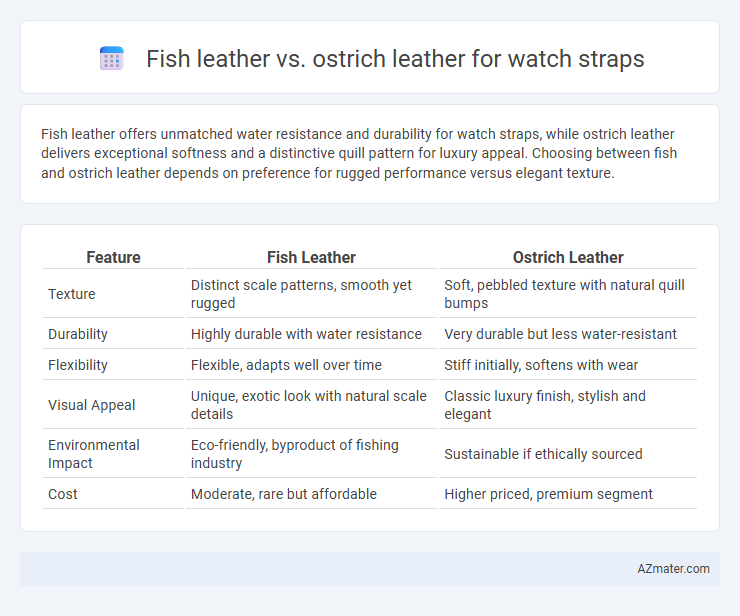Fish leather offers unmatched water resistance and durability for watch straps, while ostrich leather delivers exceptional softness and a distinctive quill pattern for luxury appeal. Choosing between fish and ostrich leather depends on preference for rugged performance versus elegant texture.
Table of Comparison
| Feature | Fish Leather | Ostrich Leather |
|---|---|---|
| Texture | Distinct scale patterns, smooth yet rugged | Soft, pebbled texture with natural quill bumps |
| Durability | Highly durable with water resistance | Very durable but less water-resistant |
| Flexibility | Flexible, adapts well over time | Stiff initially, softens with wear |
| Visual Appeal | Unique, exotic look with natural scale details | Classic luxury finish, stylish and elegant |
| Environmental Impact | Eco-friendly, byproduct of fishing industry | Sustainable if ethically sourced |
| Cost | Moderate, rare but affordable | Higher priced, premium segment |
Introduction to Exotic Leathers for Watch Straps
Fish leather offers a unique texture and exceptional durability, making it a distinctive choice for watch straps compared to traditional materials. Ostrich leather is renowned for its characteristic quill patterns and softness, providing both luxury and resilience. Both exotic leathers provide remarkable strength and aesthetic appeal, enhancing the exclusivity and craftsmanship of premium watch straps.
What is Fish Leather?
Fish leather, crafted from the skins of species like salmon, cod, or trout, offers a unique texture characterized by natural scale patterns and exceptional durability. This sustainable material is thinner and more flexible than traditional cowhide, making it ideal for watch straps that require both comfort and longevity. Compared to ostrich leather, which is known for its distinctive quill follicle pattern and softness, fish leather provides a more exotic appearance and enhanced water resistance, appealing to eco-conscious consumers seeking innovative alternatives in luxury accessories.
What is Ostrich Leather?
Ostrich leather, sourced from the hide of the African ostrich, is renowned for its distinctive quill follicle pattern, offering a unique textured appearance and exceptional softness ideal for luxury watch straps. This leather's natural oils provide high flexibility, durability, and resistance to cracking, making it a premium choice compared to fish leather, which is thinner and less resilient. Consequently, ostrich leather watch straps are favored for their combination of distinctive aesthetics and long-lasting performance.
Durability: Fish Leather vs Ostrich Leather
Fish leather, particularly from species like salmon and perch, offers high durability due to its dense fiber structure and natural flexibility, making it resistant to stretching and tearing. Ostrich leather is renowned for its strength and unique quill pattern, providing excellent resistance to wear and aging but may require more maintenance to preserve its texture. When comparing durability for watch straps, fish leather tends to be more water-resistant and lightweight, while ostrich leather excels in long-term robustness under daily use.
Aesthetic Appeal and Texture Comparison
Fish leather offers a unique aesthetic with its distinct scale patterns and natural sheen, providing a sleek, modern look for watch straps. Ostrich leather is renowned for its characteristic quill bumps, lending a luxurious, textured surface that exudes a classic and sophisticated appeal. In terms of texture, fish leather is typically smoother and more supple, while ostrich leather provides a slightly more robust and tactile feel, enhancing the strap's visual and sensory experience.
Comfort and Wearability
Fish leather offers exceptional softness and flexibility, making it highly comfortable for watch straps, while its natural grain provides a unique texture that molds well to the wrist over time. Ostrich leather is renowned for its durability and distinctive quill pattern, providing a luxurious yet breathable material that maintains comfort during extended wear. Both leathers excel in wearability, but fish leather tends to be lighter and more adaptable for sensitive skin, whereas ostrich leather offers robust resilience and a sophisticated aesthetic.
Sustainability and Environmental Impact
Fish leather offers a highly sustainable alternative for watch straps due to its use of byproducts from the fishing industry, reducing waste and minimizing the need for additional animal farming resources. It requires less water and energy in processing compared to ostrich leather, which involves more intensive land and feed consumption, contributing significantly to greenhouse gas emissions. Choosing fish leather helps promote circular economy principles and lowers the overall environmental footprint associated with luxury watch accessories.
Maintenance and Care Requirements
Fish leather watch straps demand gentle cleaning with mild soap and water to maintain their delicate scales and prevent drying or cracking, while avoiding excessive exposure to moisture. Ostrich leather straps offer greater durability and resistance to wear, requiring periodic conditioning with specialized leather creams to preserve their natural oils and supple texture. Both materials benefit from avoiding prolonged sunlight and humidity to extend their lifespan and retain aesthetic appeal.
Cost and Market Availability
Fish leather, particularly from salmon or perch, offers a cost-effective alternative to ostrich leather, with prices generally 30-50% lower due to its abundance and easier processing methods. Ostrich leather is prized for its distinctive quill pattern and durability, commanding higher market prices and limited availability from specialized suppliers. Both materials are sought after in luxury watch strap markets, but fish leather's growing popularity is driven by sustainability and affordability.
Which Leather is Best for Your Watch Strap?
Fish leather offers exceptional durability and a unique scale pattern, making it an ideal choice for watch straps that demand both resilience and distinctive style. Ostrich leather is renowned for its softness, flexibility, and characteristic quill patterns, providing a luxurious feel and elegant appearance. Choosing between fish leather and ostrich leather for your watch strap depends on whether you prioritize tough texture and exotic aesthetics or supple comfort and classic sophistication.

Infographic: Fish leather vs Ostrich leather for Watch strap
 azmater.com
azmater.com